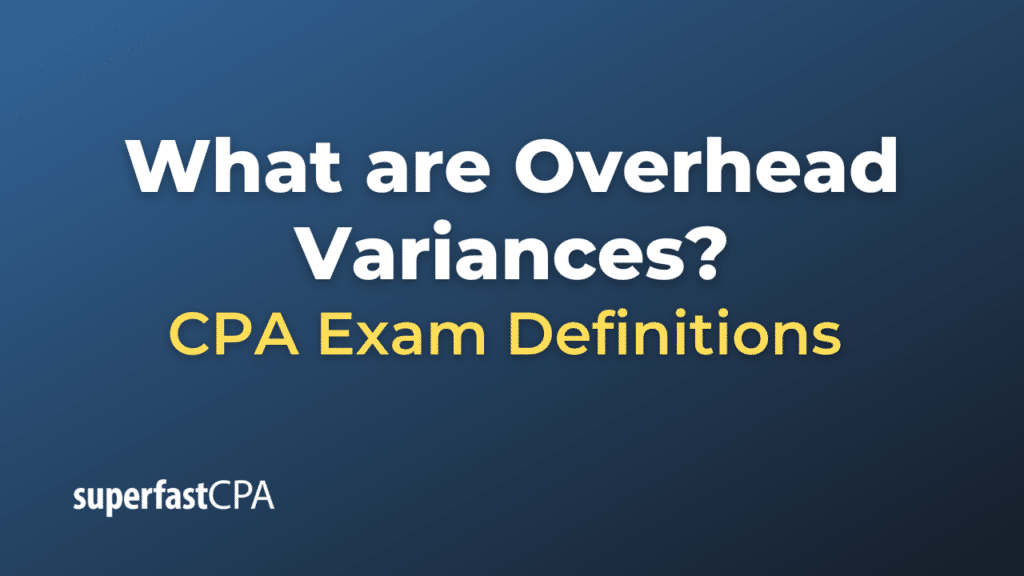Overhead Variances
Overhead variances in cost accounting refer to the difference between the actual overhead costs incurred and the standard or budgeted overhead costs. These variances help management understand whether the company is operating efficiently or whether costs are higher or lower than expected.
Overhead variances are typically split into two categories:
- Variable Overhead Variance: This involves comparing the actual variable overhead with the standard variable overhead. Variable overhead costs are those that fluctuate with the level of production, such as electricity used in manufacturing.
- Fixed Overhead Variance: This compares the actual fixed overhead with the standard fixed overhead. Fixed overhead costs are those that do not change with the level of production, like rent or property taxes.
Each of these categories is further divided into two components:
- Spending variance (or expenditure variance): This measures the difference between the actual costs and the budgeted costs. If actual costs are higher than budgeted, you have an unfavorable spending variance; if actual costs are lower, the variance is favorable.
- Efficiency variance (or volume variance): This measures the difference between the budgeted overhead based on actual hours worked and the budgeted overhead based on standard hours for actual production. An efficiency variance can be unfavorable (if more hours were needed than expected) or favorable (if fewer hours were needed).
By understanding and analyzing overhead variances, companies can identify areas where costs are higher than expected, or where operations are more efficient, and adjust their strategies and processes accordingly.
Example of Overhead Variances
Let’s consider an example of a manufacturer, XYZ Manufacturing Co., that produces a specific type of machinery:
- Variable Overhead Variances
At the beginning of the year, XYZ Manufacturing Co. budgets $20 per machine hour for variable overhead costs, expecting to use 5,000 machine hours throughout the year. Therefore, the standard (or budgeted) variable overhead cost is $100,000 ($20 per machine hour * 5,000 machine hours).At the end of the year, the company finds that it actually used 5,200 machine hours and incurred $104,500 in variable overhead costs.The variable overhead spending variance is the difference between the actual costs and the budgeted costs based on actual hours. In this case, it would be $104,500 (actual cost) – 4,000 (budgeted cost based on $20 per machine hour * 5,200 actual machine hours) = $500 unfavorable. This indicates that the company spent $500 more on variable overhead than expected for the actual machine hours used.The variable overhead efficiency variance is the difference between the budgeted overhead based on actual hours worked and the budgeted overhead based on standard hours. Here, it would be $104,000 (budgeted cost based on actual hours) – $100,000 (standard cost based on budgeted hours) = $4,000 unfavorable. This shows that the company needed to use 200 more machine hours than expected, leading to an extra $4,000 in overhead costs. - Fixed Overhead Variances
XYZ Manufacturing Co. also budgets $150,000 for fixed overhead costs for the year.At the end of the year, the company finds that it actually incurred $155,000 in fixed overhead costs.The fixed overhead budget variance (equivalent to spending variance in variable overhead) is the difference between the actual fixed overhead costs and the budgeted amount. In this case, it would be $155,000 (actual cost) – $150,000 (budgeted cost) = $5,000 unfavorable. This means the company spent $5,000 more on fixed overhead than expected.Note: Fixed overhead efficiency variance doesn’t exist because fixed overhead doesn’t change with the volume of production.
By calculating these variances, XYZ Manufacturing Co. can see that it has spent more than expected on both variable and fixed overhead, and it used more machine hours than planned. The company can use this information to investigate the causes of these variances and make adjustments as needed to improve efficiency and control costs.













